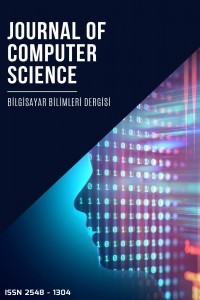Runge Kutta Yöntemleriyle Rasgelelik Analizi
Rasgele Sayı Üreteçleri, Runge Kutta, Kaotik Haritalar, Kayan Noktalı Sayılar
Randomness Analysis With Runge Kutta Methods
___
- [1] E. M. Esin, “Knutt / Durstenfeld Shuffle Algoritmasının Resim Şifreleme Amacıyla Kullanılması,” Politek. Derg., vol. 12, no. 3, pp. 151–155, 2009, doi: 10.2339/2009.12.3.
- [2] A. Akgül, M. Z. Yıldız, Ö. F. Boyraz, E. Güleryüz, S. Kaçar, and B. Gürevin, “Microcomputer-based encryption of vein images with a non-linear novel system,” J. Fac. Eng. Archit. Gazi Univ., vol. 35, no. 3, pp. 1369–1385, 2020, doi: 10.17341/GaziMfd.558379.
- [3] H. Li, L. Deng, and Z. Gu, “A Robust Image Encryption Algorithm Based on a 32-bit Chaotic System,” IEEE Access, vol. 8, pp. 30127–30151, 2020, doi: 10.1109/ACCESS.2020.2972296.
- [4] S. Chen, X. X. Zhong, and Z. Z. Wu, “Chaos block cipher for wireless sensor network,” Sci. China, Ser. F Inf. Sci., vol. 51, no. 8, pp. 1055–1063, 2008, doi: 10.1007/s11432-008-0102-5.
- [5] X. Tong, Z. Wang, Y. Liu, M. Zhang, and L. Xu, “A novel compound chaotic block cipher for wireless sensor networks,” Commun. Nonlinear Sci. Numer. Simul., vol. 22, pp. 120–133, 2015.
- [6] Z. Liu et al., “Color image encryption by using Arnold transform and color-blend operation in discrete cosine transform domains,” Opt. Commun., vol. 284, no. 1, pp. 123–128, 2011, doi: 10.1016/j.optcom.2010.09.013.
- [7] Y. Zhang, “The unified image encryption algorithm based on chaos and cubic S-Box,” Inf. Sci. (Ny)., vol. 450, pp. 361–377, 2018, doi: 10.1016/j.ins.2018.03.055.
- [8] R. U. Ginting and R. Y. Dillak, “Digital color image encryption using RC4 stream cipher and chaotic logistic map,” 2013 Int. Conf. Inf. Technol. Electr. Eng., pp. 101–105, 2013.
- [9] A. Jolfaei and A. Mirghadri, “Image Encryption Using Chaos and Block Cipher,” Comput. Inf. Sci., vol. 4, no. 1, pp. 172–185, 2010, doi: 10.5539/cis.v4n1p172.
- [10] M. Khan, T. Shah, and S. I. Batool, “Construction of S-box based on chaotic Boolean functions and its application in image encryption,” Neural Comput. Appl., vol. 27, no. 3, pp. 677–685, 2016, doi: 10.1007/s00521-015-1887-y.
- [11] Y. Liu, X. Tong, and J. Ma, “Image encryption algorithm based on hyper-chaotic system and dynamic S-box,” Multimed. Tools Appl., vol. 75, no. 13, pp. 7739–7759, 2016, doi: 10.1007/s11042-015-2691-5.
- [12] I. Cicek, A. E. Pusane, and G. Dundar, “A novel design method for discrete time chaos based true random number generators,” Integr. VLSI J., vol. 47, no. 1, pp. 38–47, 2014, doi: 10.1016/j.vlsi.2013.06.003.
- [13] K. I. Farhana Sheikh Leonel Sousa, Ed., “Circuits and Systems for Security and Privacy” .
- [14] A. Akgul and I. Pehlivan, “A New Three-Dimensional Chaotic System Without Equilibrium Points, Its Dynamical Analyses and Electronic Circuit Application,” Teh. Vjesn., vol. 23, pp. 209–214, 2016, doi: 10.17559/TV-20141212125942.
- [15] N. Munir, M. Khan, T. Shah, A. S. Alanazi, and I. Hussain, “Cryptanalysis of nonlinear confusion component based encryption algorithm,” Integration, vol. 79, no. February, pp. 41–47, 2021, doi: 10.1016/j.vlsi.2021.03.004.
- [16] H. G. Mohamed, D. H. Elkamchouchi, and K. H. Moussa, “A novel color image encryption algorithm based on hyperchaotic maps and mitochondrial DNA sequences,” Entropy, vol. 22, no. 2, pp. 7279–7297, 2020, doi: 10.3390/e22020158.
- ISSN: 2548-1304
- Yayın Aralığı: Yılda 2 Sayı
- Başlangıç: 2016
- Yayıncı: Ali KARCI
LSTM Öğrenme modeliyle COVID-19 Tweetleri üzerinde Duygu Analizi
Yunus Emre KARACA, Serpil ASLAN
İki Parçalı Ağda Bağlantı Tahminine Dayalı İlgi Çekici Nokta Tavsiyesi
Elifgül ÇAKMAK, Buket KAYA, Mehmet KAYA
Dengeli Dağılım Sergilemeyen Dermoskopik Görüntü Veri Seti Üzerinde CNN Modelleri Karşılaştırma
CT Görüntülerinden Covid-19 Tespiti için CNN Tabanlı Bir Yöntem
Veri Göçü Sonrasında Çizge Veri Tabanları Üzerinde Desenlerin İncelenmesi
Ramazan ALTIN, A. Cumhur KINACI
Derin Öğrenme Yöntemleri ile Sıcaklık Tahmini: Diyarbakır İli Örneği
Muhammed Saadetdin KAYA, Kenan İNCE
Bilimsel dergi tavsiyesi için içerik tabanlı bir yaklaşım
Çoklu Nesne Takibi FairMOT Algoritması İçin Optimizasyon Algoritmalarının Karşılaştırılması
Mehmet Fatih ÖZDEMİR, Ali ARI, Davut HANBAY
Engellilerin Taleplerinin Yapay Zeka Yöntemleriyle Belirlenmesi
